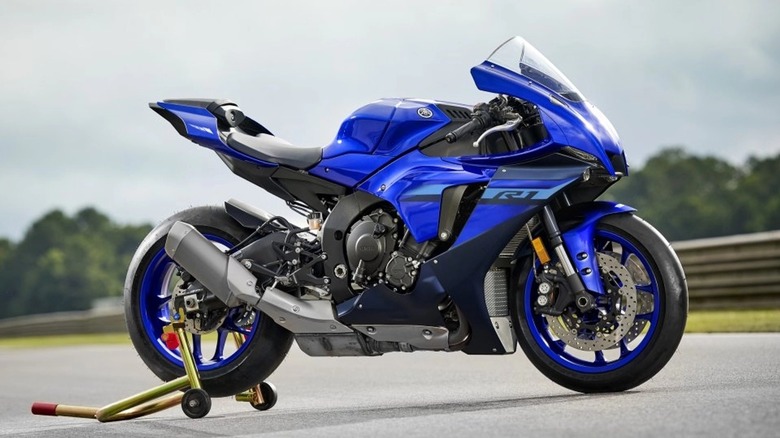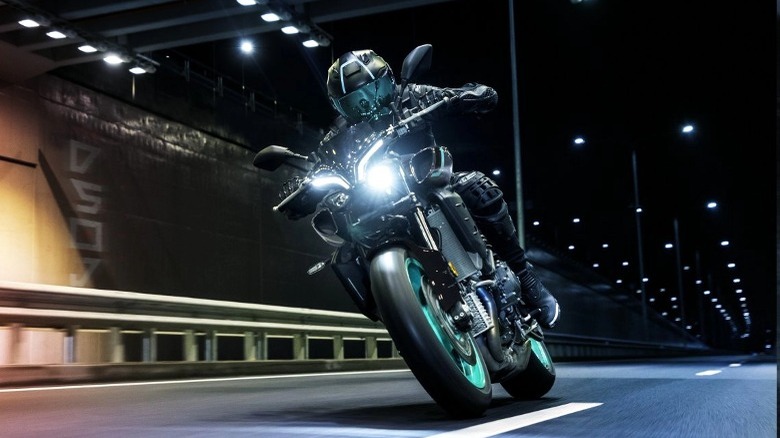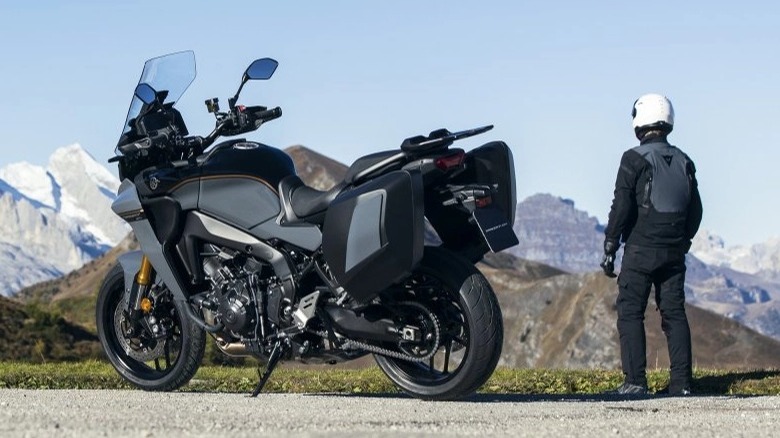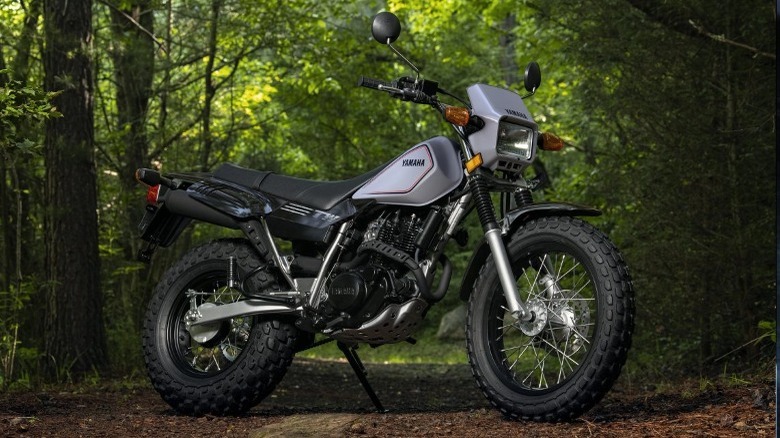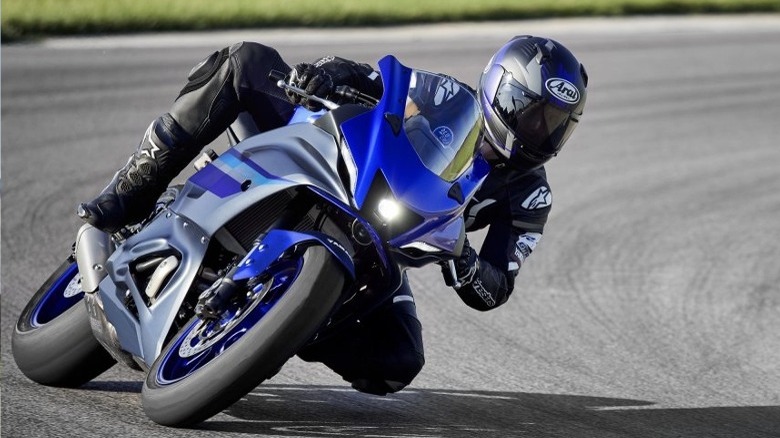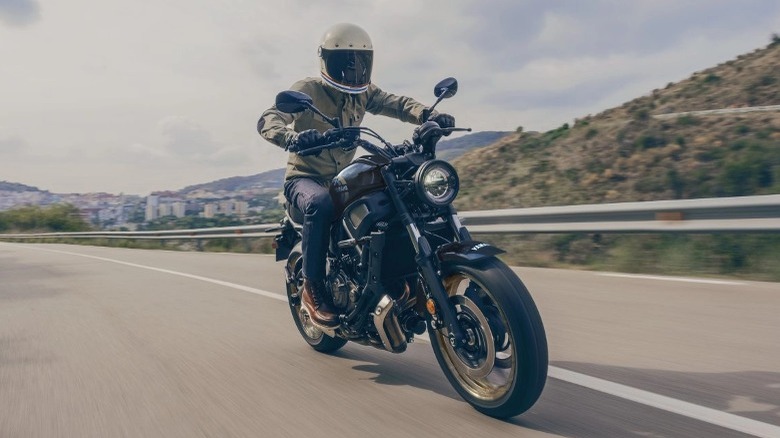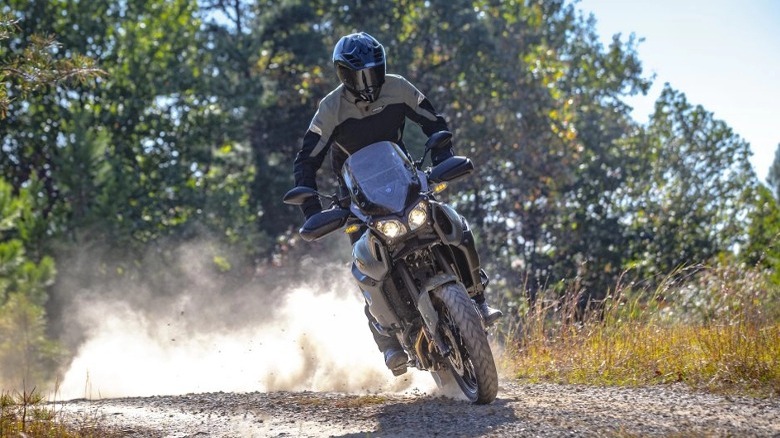The Pros And Cons Of Buying A Used Yamaha Motorcycle
New motorcycles can be expensive, so many budget-minded buyers may be inclined to check the used market to see what's available. You can look at local listings to see what nearby used lots have in stock, or you can take a look at public markets such as Craigslist and Facebook Marketplace and potentially save even more money by getting a bike directly from the previous owner. I've done this several times, so I know that there are some things that you need to look out for when buying a used motorcycle.
One brand in particular that you might be thinking about looking into is Yamaha — one of the biggest motorcycle manufacturers in the world. It makes all kinds of different models, from sports bikes and naked street bikes to dual-sport and touring motorcycles. While there are a handful of Yamaha models that you should steer clear of on the used market, the brand is by and large considered to be one of the most reliable and reputable motorcycle manufacturers on the market. Even so, there are pros and cons to buying a used motorcycle from any brand. Here are three pros and three cons of buying a used Yamaha.
Pro: Yamahas aren't hard to find
Many riders consider Yamaha to be one of the best motorcycle brands in the world. That might be subjective, but there's no denying that it's one of the most popular. MotorCycles Data compared the global sales of every major motorcycle brand in 2023. They found that Yamaha was the third-best-selling brand in the world after Honda and the Indian motorcycle manufacturer Hero Motor, with a cumulative $4.6 million in sales. That isn't anything new for Yamaha, either. The company's best year was actually in 2012, when it earned 12.5% of all motorcycle sales.
So what does that mean in terms of buying one used? Well, it means there's a whole heck of a lot of them out there. The used market varies from place to place, but you can probably find a used Yamaha just about anywhere. I live in a medium-sized city in Oregon that has a population of 60,000, and a quick search of my local Facebook Marketplace for Yamaha bikes yielded hundreds of results within a 30-mile radius. There were bikes of every form factor at a wide variety of price points and models spanning decades. Some of them were over 50 years old, while others were manufactured as recently as 2024. There are just under 5,000 used Yamaha motorcycles currently listed for sale on Autotrader in the U.S. and over 17,000 listed for sale on Cycle Trader at the time of writing — so as long as there is a reasonably sized used motorcycle market in your area, you shouldn't have much trouble finding one.
Con: You may not be able to get the exact model you want
One of the biggest downsides to purchasing a used motorcycle is that you have far less control over which models and years are available to you. Sure, you can probably find some variety of Yamaha street bike pretty easily, but it might be a little more difficult to track down a 2020 Yamaha V-Max that's in good condition with low miles at a reasonable price — especially since it's considered one of the best motorcycles that Yamaha has ever made. The more specific the target, the harder it's going to be to find it.
This is doubly true for Yamaha's most desirable models. Certain bikes, such as the XS11000, are incredibly popular among collectors, so finding ones that are in good working condition can be tricky. Of course, you can always check for the specific year and model that you want. You might get lucky. But if you have a fixed budget you are probably going to either have to be flexible with the kind of bike you're getting, or you're going to have to be patient and hope that the one you really want eventually comes available.
Pro: You can get a used Yamaha for cheap
There are a few expensive Yamaha motorcycles out there, such as the competition-grade supersport YZF-R1M, but most of the bikes in the company's lineup are fairly affordable. Yamaha's pricing is competitive with similarly specced motorcycles from fellow Japanese brands Honda, Suzuki, and Kawasaki — all of which tend to be priced lower than their European counterparts.
This budget-minded price scaling translates to the used market as well. It would be hard to sell a used bike for more money than a new one, after all. This pricing can run the gamut from old junkers that you can buy for a couple of hundred dollars to almost new bikes sold at mild discounts. You're probably looking for something between those extremes, however. I found a 2022 Yama R7 for sale in my area for $6,500, for example. That's still a good chunk of money, but keep in mind that the R7 is an upper-mid-sized bike, and that price is a significant step down from the $9,199 starting point of both the 2023 and 2024 models even though it is only a single year older. You could always get an older bike if you're looking to save even more money or take a look at smaller models, such as the R3.
Con: The bike may have been dropped or damaged
Sometimes motorcycles get dropped. It can happen when a bike slides out on a sharp turn, when a rider is unprepared to handle the weight when stopping on a slope, when the bike gets knocked over by a car, or simply because the rider forgot to put the kickstand down before getting off. The damage from this can be anything from a few minor scrapes to a cracked fuel tank.
It's usually pretty obvious when a motorcycle has been dropped. The dents and scratches are often difficult to hide. But it can also be difficult to tell how extensive the damage actually is. I once bought a motorcycle that had a mild scrape on the tank and engine casing — a minor eyesore but not a deal breaker for me at the time. Both were still structurally intact, and it seemed like an aesthetic problem. The bike started easily and ran fine during my test ride. I only later learned during an evening ride that its wiring harness was damaged, and so the low-beam headlight would occasionally turn off without warning. Not ideal.
Yamaha motorcycles are as susceptible to this kind of damage as any other brand. Even if the bike hasn't been dropped, there are other kinds of damage that can be difficult to see as well. The 2015 R3, for instance, received several recalls due to an issue with water entering and corroding the ignition switch, which could potentially cause unexpected engine stalls.
Pro: Yamaha's are reliable
Yamaha makes some incredibly reliable motorcycles. This is one of the things that fans of the brand love most about it. In fact, Consumer Reports did a study in 2015 where it surveyed 12,300 of its subscribers. They did this to determine the failure rate of bikes of the most popular brands in the U.S. Yamaha had the lowest failure rate of any bike on the list, narrowly beating both Suzuki and Honda.
Reliability is an important factor for purchasing any vehicle, but it's particularly important when you're purchasing a used motorcycle that already has a few thousand miles on it. You want to be confident that the bike won't become a maintenance nightmare within the first few years at least. The whole point of buying a used bike is to save money, not to spend a fortune on maintenance costs. Motorcycle engines are typically smaller than those found in cars, and they can run very hot. This means that, on average, you probably shouldn't expect your motorcycle to hit the same high mileage markers without needing significant maintenance.
Reliability plays into this. Japanese-made bikes generally have a solid reputation for longevity, and if the Consumer Reports study is to be believed, Yamaha is the first among its peers. Of course, there will be some variance among different models within the brand. It's never a bad idea to look up the expected service associated with any bike before you buy it and compare it to the used bike's current mileage.
Con: The bike may not have received proper maintenance
Speaking of service, one of the risks that you take when you purchase a used motorcycle is that it may not have received all of the maintenance that it should have. Yamahas may be a bit more resilient than other brands, but that doesn't mean that they don't need a little care from time to time. Even if you can tell from the outside that the tires, brakes, and chain are in good shape, infrequent oil and filter changes can lead to internal engine problems that aren't clearly visible on the outside.
Each model has its own specific maintenance schedule that should be followed in order to keep the bike running the way it's supposed to. These tasks are typically listed in that bike's owner's manual. If you're lucky, the business or individual that you are buying the bike from will have records of this maintenance, and you will be able to compare it to the recommended schedule in the manual. That's rarely the case, however.
In my experience, previous owners seldom maintain a documentation record of maintenance and often don't even have the owner's manual on hand. You can get a new copy of the owner's manual from Yamaha's website, but you might want to see if the previous owner is willing to take the bike to a mechanic for inspection before committing thousands of dollars to a machine that may not have received proper care.
